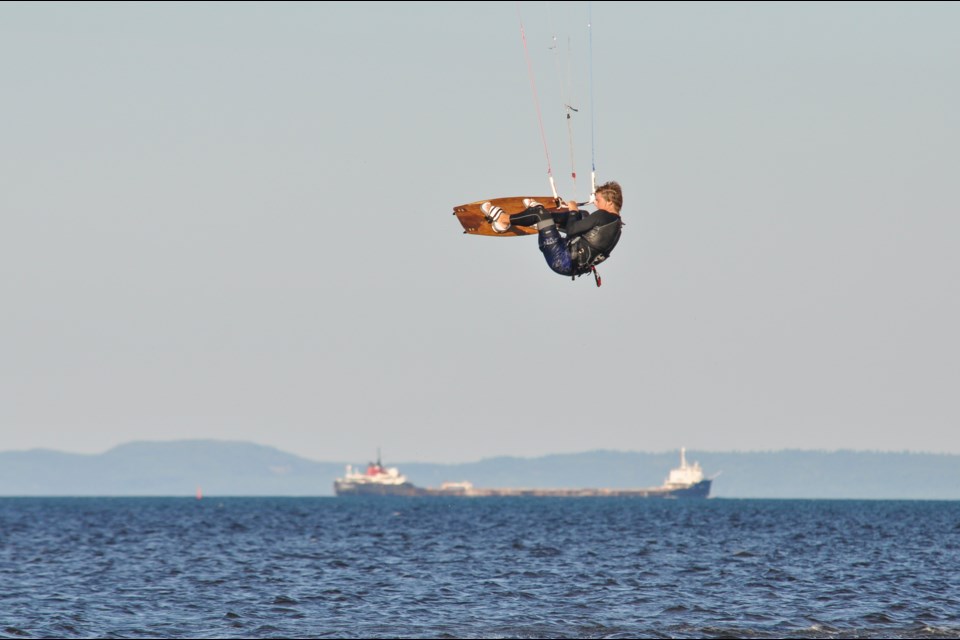Avid kiter Darren McChristie first saw snow kiting while living on Baffin Island about 20 years ago. “There was a festival, and they brought in a demonstration of snow kiting from a group of people from Quebec, where the sport was quite popular already in the early years,” he recalls.
“I fell in love with it at first sight and I bought a kite off of one of the people visiting. And I taught myself up in the arctic,” he says.
When he returned to Thunder Bay 17 years ago, McChristie continued with the sport here, and got certified to teach the winter version of the sport. Since it was still a new sport in this area, he started a company, Superior Outdoors (Superior Kiteboarding), which sells equipment. He also started learning the summer version of the sport, kiteboarding.
Kiters are harnessed to a large kite with a control bar to glide over surfaces. In the winter, you can go over snow using skis or a snowboard, and in the summer, kiters ride a kite board or foil board on water. Inflatable kites are interchangeable for summer and winter use, but some, like McChristie, prefer foil kites for winter use.
“For snow kiting, basically we can kite on any lake, but the larger the better. We like Whitefish Lake; it’s a large open lake and it freezes very quickly,” he says. “And I’ve kited across the south end of Black Bay in the winter.”
For kiteboarding, the waters off Mission Island Marsh are perfect. The area is quite shallow for over a kilometre, McChristie explains, and the bottom is sandy. “It’s deep enough that we can take jumps and not hit bottom, but if you lose your board you can stand up,” he adds.
Terrace Bay has also become more popular in recent years, with surfers as well as kiters riding its big waves. Another, lesser known location is a five kilometre-long sandy beach on the south east shore of Lake Nipigon.
“We’re looking for an uninterrupted area of open water, so that the wind can really generate,” he explains. “And we don’t want any obstructions [such as cliffs] on shore, because the wind does funny things when there are obstructions. We never kite in off-shore winds. We want the wind blowing on shore, so that should anything go wrong, we’re not blown out to the middle of the lake.”
Kiting has seen strong growth globally, and Thunder Bay also has a number of “very very dedicated people who can do amazing things,” McChristie notes. “There’s some incredibly talented athletes for sure.”
Getting started in the sport can be tricky, he says. There is no kiting school locally, and purchasing all the gear can be costly, not to mention that there is currently a global shortage of some equipment, such as control bars and kites.
“A lot of people take lessons while on vacation, somewhere warm. You’re going to spend a lot of time in the water, so that’s the safest way to learn,” he suggests. With international travel currently off limits, McChristie says it is possible to learn on your own using a trainer kite, but it takes a lot of time and patience. “Trainer kites are smaller and they don’t have enough pull to lift you off the ground. So you learn on a smaller kite, how to control the kite. Then it’s just your board skills. Some people have snowboarding experience, or skateboarding experience.”
“You can also spend some time with people who know what they’re doing down at the beach,” he adds. “Come down to the beach, [at Mission Island Marsh] the water is so shallow there, you can flounder around safely. People are friendly - check it out, ask questions.”
McChristie says he doesn’t like to call kiting an adrenaline-driven sport, but says the rush of the power of the kite can be addictive. “My favourite part about kiting is getting out far from shore where there are big rolling waves to surf,” he says. “The freedom, and the solitude - I have that wave to myself. It’s hard to describe, really.”



